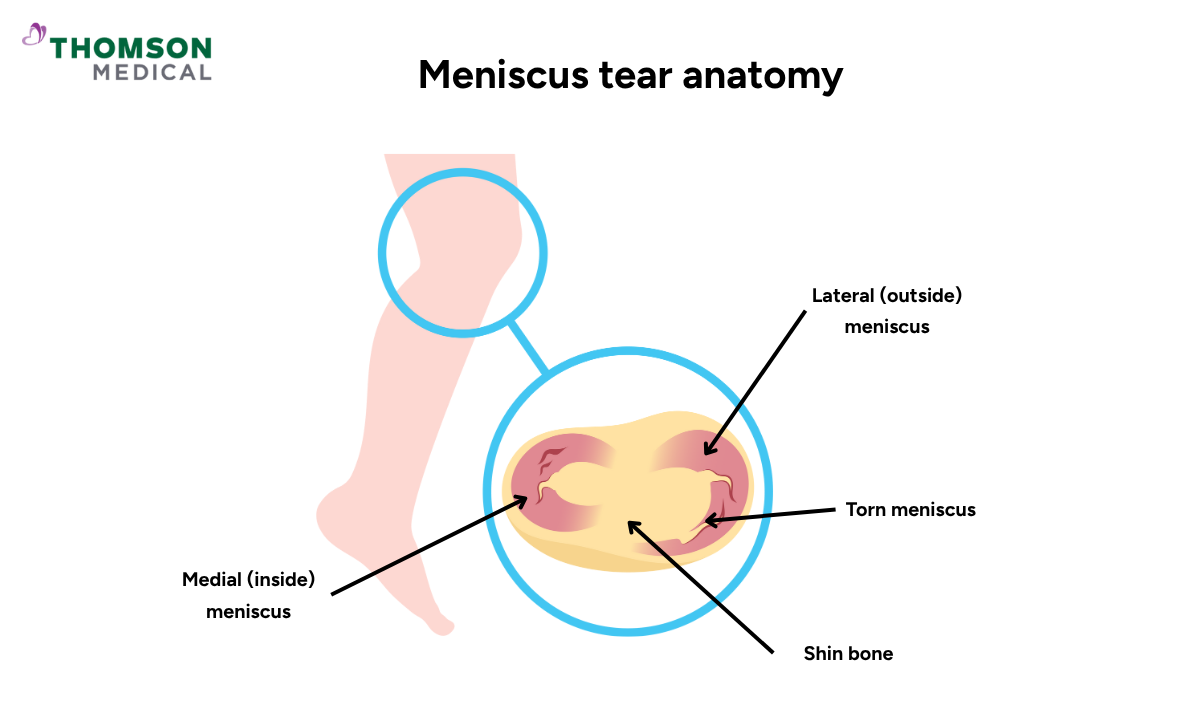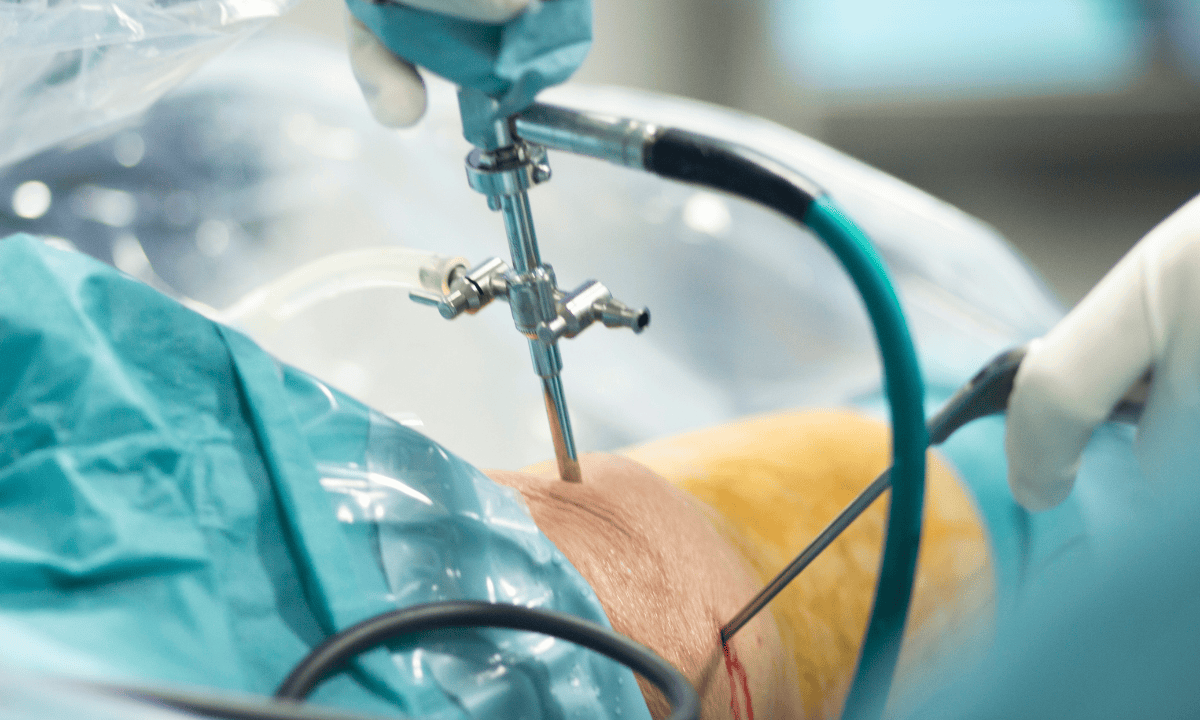When you fall during exercise or are currently experiencing a degenerative disease such as osteoarthritis, you may have unknowingly torn your meniscus. This C-shaped cartilage is located in your knee joint between your thigh bone and shin bone, acting as a shock absorber and cushioning your knees when you walk, run, or jump.
If you do have meniscus tears, you may experience symptoms such as pain, stiffness, or a locked knee. Your doctor will ask about your activities and past knee injuries, then examine your knee to assess its function.
Depending on the size and location, some meniscus tears can heal without surgery. However, most of the meniscus has a poor blood supply and does not heal well on its own. If that's the case, your doctor may recommend an arthroscopic surgery, such as meniscus debridement, to relieve pain and discomfort.
What is meniscus debridement?
Meniscus debridement is a type of arthroscopic surgery, which is a minimally invasive surgical technique. During the procedure, your doctor will make a few small incisions in your knee and insert a tiny fibre-optic camera (arthroscope) attached to a narrow tube, which allows your doctor to see inside your joint.
To remove loose, frayed, or torn portions of meniscal cartilage, your doctor will make another small incision to insert pencil-thin surgical instruments. Then, they'll trim the torn meniscus to prevent it from pinching in the knee joint and causing persistent pain.
When is meniscus debridement recommended?

Meniscus debridement is not usually the initial treatment recommended for a meniscus tear. Your doctor usually recommends a non-surgical approach first, such as resting your legs, applying ice, or undergoing physical therapy. However, if your symptoms persist or worsen, your doctor may eventually suggest this minimally invasive knee surgery.
Here are some common reasons why your healthcare provider may recommend this surgery:
You have difficulty performing daily activities
You have degenerative knee conditions, such as osteoarthritis
You aren't suitable for a meniscal repair due to your age, lifestyle, or tear condition
The torn meniscus is located in the inner part of it, where natural healing is unlikely due to a lack of blood supply
Although the meniscal debridement procedure is effective at relieving pain, swelling, knee instability, and locking, your doctor may not recommend it if you are:
Young and athletic with meniscal tears that can be treated using a meniscus repair procedure
Have severe osteoarthritis, where joint damage, not just the meniscus, is the main problem
During the procedure, your knee surgeon will aim to preserve as much of your meniscus as possible. This is because when the meniscus is partially removed, it becomes less effective at absorbing shock, which increases stress and friction in the knee joint.
These changes can potentially cause the shin and thigh bones to rub together, leading to osteoarthritis.
For further information about this procedure and to understand its potential risks, benefits, and long-term effect on your knee joint health, schedule an appointment with Thomson Medical.
What to prepare before the procedure
Prior to your surgical procedure, there is no special preparation you need to do. However, your doctor will ask you about your symptoms and examine your knee joint. Depending on the condition, they may also perform tests such as a knee MRI scan or X-ray.
To help ensure a smooth procedure, here are some things you can do:
Let your doctor know about any herbal products or medicines you are using. They'll decide whether you should stop taking these medicine before your surgery.
Depending on the type of anaesthesia you will be receiving, you may need to fast for 8 to 12 hours before your treatment.
You won't be allowed to drive yourself home afterwards, so make sure someone is available to pick you up.
Please don't hesitate to ask your healthcare provider any questions you have about these arthroscopic procedures or what to expect.
What to expect during the surgery?
On the day of your surgery, your doctor will begin by administering anaesthesia, allowing the procedure to commence. The surgery usually lasts between 20 and 40 minutes. Here is what you can expect during the procedure:
Incision:
Your surgeon will make two small incisions over your injured knee to allow arthroscopic access to your knee joint.
Assessment:
Your doctor then inserts the arthroscope to assess the inside of your knee, checking for meniscal tears, ligament damage, or other cartilage conditions.
Meniscal debridement:
Through additional small incisions around the joint, your surgeon inserts a pencil-thin surgical instrument.
These tools allow them to grasp, cut, and remove damaged cartilage as needed. The torn meniscus is carefully trimmed to create a stable edge that won't get pinched within the joint.
Closure:
After the procedure, the joint will be thoroughly flushed with a sterile solution to remove any debris, and the small incisions are closed with sutures or adhesive strips.
Benefits of meniscus debridement

Meniscus debridement offers several benefits if you have meniscal tears that are not suitable for a meniscus repair, which include:
Lower infection risk
Small surgical incisions
Immediate relief from catching or locking sensations in your knee
It is an outpatient procedure, so you can go home the same day
Meniscus debridement has a shorter recovery time than a meniscus repair, typically taking weeks instead of months
Meniscus debridement can delay the need for more invasive procedures, such as total knee replacement surgery
Risks of meniscus debridement
Although arthroscopic treatment is generally safe, there is still a risk of complications associated with this procedure.
Your orthopaedic surgeon will mitigate this by reviewing these risks with you beforehand and taking proactive measures. Here are potential complications that might happen post-surgery, including:
Bleeding inside the knee
Postoperative stiffness or swelling
Blood clots, though rare with arthroscopy
Accelerated cartilage wear due to removal of cushioning tissue
Incomplete symptom relief, especially if osteoarthritis is also present
If you would like more information about a meniscus debridement procedure, schedule an appointment with Thomson Medical. Our specialists can help explain this procedure to you in more detail and determine whether it is suitable for your meniscal tear condition.
Recovery from meniscus debridement
Meniscus tears that are treated by debridement have a much shorter recovery time than those that are treated through a meniscus repair. The timeline for your recovery following knee arthroscopy surgery is as follows:
Day 1-3:
It is recommended that you follow the RICE (rest, ice, compression, and elevation) protocol right after surgery.
You may need crutches to help with balance while standing or walking.
If your job doesn't involve much movement, such as if you work remotely, you can return to work within 2 days.
Week 1:
After a week, you can start walking with minimal support
Your physiotherapist will guide you through gentle range-of-motion exercises.
By this time, everyday activities will be more comfortable, but more physically demanding jobs may require additional time off.
Week 2-3:
After week 2, you can return to your daily routine and walk further.
Your physiotherapist will also introduce some light strength training exercises.
Weeks 4-6:
By the end of the first month, you will usually have returned to 80% of your pre-injury activity level.
During this time, your physiotherapist will implement more vigorous rehabilitation exercises.
You can begin doing non-impact sports and more physically demanding work.
Week 6+:
You can make a complete return to sports and physically demanding work, based on your fitness level and your surgeon's approval.
During this time, you can usually return to 95% of your pre-injury activity level.
Recovery times may vary depending on your individual circumstances, activity level, and adherence to rehabilitation protocols. Your surgeon and physiotherapy team will guide you through each stage of recovery.
FAQ
How long does the meniscus debridement procedure take?
The meniscus debridement procedure usually takes between 20 and 40 minutes. However, if additional procedures such as chondroplasty (smoothing or cleaning damaged cartilage in your knee joint) or synovectomy (removing inflamed or overgrown joint lining) are performed during the procedure, it may take longer.
Can I bend my knee after meniscus debridement?
Yes, you can usually start bending your knee within a few days of the surgery, though deep bending may be harder at first due to swelling. It is important to start moving around early to prevent stiffness and keep your knee joint flexible
Can a torn meniscus heal without debridement?
Small, stable tears in the outer, vascular part of the meniscus may heal with rest, ice, or physical therapy. However, degenerative or complex tears on the inside of the meniscus usually require surgical intervention, as they don't heal well on their own.
Can I walk after knee debridement?
Yes, you will usually be able to walk on the same or next day after surgery, often with the help of crutches or a walking stick. However, more physically demanding activities that require full weight-bearing on the knee joint will need additional time before they can be resumed.
Is debridement of the meniscus the same as meniscectomy?
No, but they are closely related procedures:
- Debridement refers to the removal of frayed or damaged meniscus tissue while preserving as much of the healthy meniscus as possible. This helps maintain knee function and reduces the risk of future joint problems.
- Meniscectomy, on the other hand, involves removing a significant portion or even the entire meniscus.
Debridement is generally less invasive and preserves more tissue than meniscectomy, making it the preferred option when possible.
Does meniscus debridement increase the risk of knee arthritis?
Yes, meniscus debridement can increase the risk of knee arthritis, particularly if a large portion of the meniscus is removed, if there is already cartilage damage in the joint, or if you return to high-impact activities too soon.
To help reduce this risk, your surgeon will preserve as much healthy meniscus tissue as possible during the procedure.
This information is intended as general guidance only and should not be considered as medical advice. For personalised health screening recommendations based on your medical conditions, schedule an appointment with Thomson Medical.
For more information, contact us:
Thomson Specialists (Thomson Medical Centre) — Orthopaedic
Request an Appointment